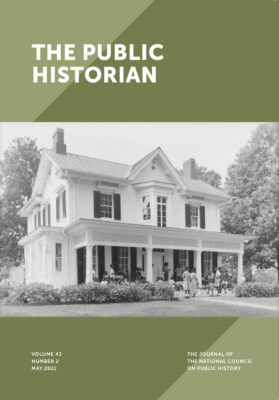Editor’s Corner: the shadow of a pandemic
12 May 2021 – Sarah H. Case

The cover of the May 2021 issues of “The Public Historian” features a photograph of the Frederick Douglass House, Washington, DC, circa. 1933. Learn more about this house in Tara Y. White’s essay “History as Uplift: African American Club Women and Applied History.” Photo credit: Library of Congress
Editors’ Note: We publish the editor’s introduction to the May 2021 issue of The Public Historian here. The entire issue is available online to National Council on Public History members and to others with subscription access.
Several contributions to this issue in some way reflect the ongoing effects of the COVID-19 pandemic on public history scholarship and labor. Last March, NCPH planned to meet in Atlanta to commemorate the organization’s fortieth anniversary. The conference theme, “Threads of Change,” inspired Rebecca Conard, past president of NCPH, to organize a roundtable to examine the multiple origin stories of public history, centering particularly the work of those underrepresented in traditional accounts of the emergence of the field. Although pandemic-related health concerns and travel restrictions led to the cancelation of the in-person conference, we bring you the roundtable, titled “Threads of Origin,” in our pages. Here, Tara White centers the work of the National Association of Colored Women in identifying and preserving Black history at the turn of the twentieth century. She shows that before the establishment of professional organizations dedicated to African American history, “Black clubwomen had used publications, public lectures, exhibitions, pageants, and curriculum projects to show the historical contributions of African Americans to American history.” In her essay, Ashley Bouknight-Claybrooks also links Black historical work with Black activism, arguing that “although not as visible as sit-ins and boycotts, the efforts of . . . repositories to preserve and disseminate Black history during periods of social unrest was vital to the forward progression of the Black Freedom Movement.” By looking outside of the US mainland, Lara Kelland’s essay examines heritage work in Puerto Rico, examining how contests over colonialism shaped both the official public history and the less formal collective memory on the island in ways that complicate what are often perceived as “the differences between the formal bounds of the fields of public history and collective memory.” Theodore Karamanski’s comment concludes the roundtable.
Also looking to the Caribbean, Mairi Cowan and Christoph Richter find that the “Faro a Colón,” or “Columbus Lighthouse,” a huge monument to Christopher Columbus in Santo Domingo, Dominican Republic, inadvertently serves as a fitting way to remember Columbus. Intended to be awe-inspiring and celebratory, Cowan and Richter find that an informed and critical viewer can perceive that the monument ironically communicates his legacy “of misplacement, displacement, grasping greed, and the extinguishing of many lights.”
The issue also features a “Report from the Field” by Katie Stringer Clary and Carolyn Dillian of Coastal Carolina University about their project Printing the Past: SC in 3D. The project brought together university students, a local historical museum, community stakeholders (including descendant communities), and nonprofits serving people with visual disabilities, neurodivergence, and sensory processing differences. Using 3-D technologies, the project featured scanned and printed objects based on historical and archeological artifacts that visitors could handle and engage with tactilely. The project offers a model of making museum collections accessible as well as working effectively with multiple partners.
Reminding us that public history institutions are also sites of labor, Andy Urban interviewed former members of the union representing employees of the Lower East Side Tenement Museum. Gaining recognition in 2019, the union made progress in negotiations until COVID-19 closures prompted lay-offs in March and July 2020. Urban’s interview allows museum employees to vocalize their concerns as workers and as public historians. As he notes, low pay and part-time hours make many museum jobs possible only for those who have other sources of income and limit who can interpret the past at these institutions. Urban writes, “workers at the Tenement Museum see collective bargaining rights as a tool to help mitigate the class and racial privileges that limit workers’ entry into, and ability to stay in, jobs at the museum.”
This issue also features a review essay by Anna Sexton surveying responses to COVID-19 by archivists and collectors, focusing primarily on the UK but including other areas as well. Sexton particularly considers the ethical issues surrounding collecting during the pandemic and, by extension, during other times of trauma. Her concerns about labor, grief, loss, and responsibility speak to us as we continue to grapple with the long-term consequences of what has been a profoundly difficult year.
~Sarah H. Case, the editor of The Public Historian, earned her MA and Ph.D. in history at the University of California, Santa Barbara, where she is a continuing lecturer in history, teaching courses in public history, women’s history, and history of the South. She is the author of Leaders of Their Race: Educating Black and White Women in the New South (Illinois, 2017) and articles on women and education, reform, and commemoration.



